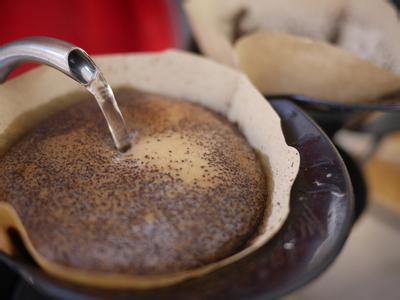A brief introduction to Coffee planting History and planting techniques

According to historical records, coffee trees were first planted in Taiwan in 1884, and coffee cultivation in mainland China began in Yunnan. In 1902, a French missionary named Tian introduced seeds from "Yingong" in Binchuan County, Yunnan Province. it was successfully planted in a place called Zhu Kula, a tributary of the Jinsha River.
The commercial cultivation of coffee in Yunnan began in 1985, but the development is slow. In 1995, the Yunnan provincial government formally put Yunnan coffee cultivation into the "18th" project, and coffee cultivation has developed rapidly, and now it has become the only raw material base for high-quality coffee in China, accounting for 95% of the country's total output.
In 1884, coffee was successfully planted in Taiwan.
In 1902, Chinese mainland successfully introduced and planted coffee in Binchuan, Yunnan Province.
In 1985, Yunnan Agricultural Reclamation began to grow coffee commercially.
In 1992, UNDP assisted China to build its first modern coffee processing plant, Yunnan Coffee Factory.
In 1995, the coffee industry was included in the innovative project of biological resources development in Yunnan.
In 2003, Yunnan became the only high-quality coffee raw material base in China.
In Europe
Coffee formed a tradition in Europe after the development of coffee roasting technology in the Middle East at the end of the 14 th century. It was introduced through an exchange between the Ottoman Turkish Empire and the merchants of Venice, a Mediterranean trader. Coffee flourished in the 18 th century. Islamists call coffee a "divine medicine given by Allah." So coffee is called "coffee" or "cavha", which means a drink that brings energy to people.
Coffee was introduced into Europe at the end of the 17th century when the earliest coffee shops appeared. Since this period, coffee has entered into European life from a simple hobby, and this conscious behavior has gradually increased in life. In the early 18th century, British aristocrats held coffee salons at home to enjoy coffee time. Parisians who are passionate about social and artistic activities are also born in cafes.
In this way, the role and role of coffee gradually spread from business to social, leisure, creative and other cultural fields. But the popularity of coffee is not just smooth. There is also a lot of opposition and suppression. There are also countries that ban coffee, and there were times when Pacas, the god of wine, regarded coffee as an antidote to alcohol. And it is widely accepted that coffee causes insomnia. In spite of this, the popularity of coffee, known as "Islamic red wine" or thinker's milk, has accelerated. After the 19th century, some countries have developed it as an industry.
Europe, which has ruled coffee culture for four centuries, is now blowing a new wind. Unlike American leisure coffee and Japanese-style filter coffee, the whole European coffee culture based on Espresso is showing a more exuberant trend.
Europeans have gone deep into people's lives and formed a culture 200 years ago and have a strong concern for and interest in coffee. Consumers are not only very strict about the quality of coffee, they think that creativity in taste and authenticity and consistency in related professionalism, artistry, history and experience are also very important. Here, the tendency to choose appropriate products is gradually formed that "concern for the environment exists in production and processing, and there is no disadvantage in every aspect of the circulation process".
There is no doubt about the authenticity of H.R. (Higgins) in London, England. Three generations have worked hard for the original taste of coffee since they started their business for more than 100 years. Now there are more than 15 kinds of comprehensive coffee. They do not care about the quality and authenticity of coffee in terms of external praise and interests, and now serve as an important business in providing coffee to the most expensive British royal family.
Now the establishment of the European Special Coffee Association has promoted the development of European coffee culture to a new stage. Through the spread of coffee such as Baristar competitions, ensuring the supply of high-quality coffee through visits to production places and coffee bidding, and gathering popularity through coffee organizations such as Fair Trade and Organic, these activities all predict the blueprint of European coffee in the future.
Planting technology
The planting techniques of herbal coffee are as follows:
First, planting time: April 15-25 period.
Second, planting location: plain, hillside, wasteland, front and back house, forest and fruit tree seedlings can be planted, but should not be planted in tall trees or other unventilated places.
Third, herbal coffee does not like flood and fertilizer, conditional planting can use farm manure, during the growth period, it is best to irrigate 1-2 times of water during the growth period, and all kinds of chemical fertilizers and herbicides are absolutely not allowed.
IV. Growth habits
Coffee beans like warmth, drought and cold tolerance, afraid of freezing, seedlings and adult plants are vulnerable to frost defoliation to death, seeds can not mature. Coffee beans are not strict on land, and idle land can also be planted, but it is suitable for sandy soil with good drainage, deep soil layer and loose and fertile soil.
5. Planting techniques
Seed selection: the germination rate of seeds should be tested before sowing. Specific method: divide the full seeds into several parts, number them in turn, take out 125 to 250 grams in each part and put them into corresponding numbered utensils, soak them in warm water for about 50 ℃ for one day and night, pour out the water, rinse it again with clean water, then cover it with a wet cloth to maintain humidity, sprout after three days, and select those with a bud rate of more than 85% as seeds.
Soil preparation: in the selected plots, 2000-2500 kg of ring fertilizer and 25 kg of superphosphate are applied per mu, which are evenly scattered on the ground, ploughed and raked fine and leveled, and generally do not make beds. If a bed is made, it can be made into a flat bed 1.2 to 1.5 meters wide.
Sowing: soak the superior seeds selected by the test in 50 ℃ warm water for one day and night, wait for them to absorb water to expand, fish out the dry surface, and sow seeds. The sowing time is from Qingming Festival to Grain Rain (mid-April), when the air temperature is 15-20 ℃, it is too early, the ground temperature is low, the seeds are easy to rot in the soil, and too late, the seeds can not mature, affecting the yield and quality. Sowing with strip sowing is appropriate, row spacing 50-70 cm, open 5-6 cm deep ditch, spread seeds evenly in the ditch, cover soil 3 cm, slightly suppress, and emerge about 10 days after sowing. If there is a drought in the north, it is necessary to irrigate before sowing, not to water after sowing, so as to avoid topsoil consolidation affecting seedling emergence.
VI. Field management
Loosening soil and weeding: when the seedling height is 3-6 cm, the weak or overdense seedlings are pulled out; when the seedling height is 10-13 cm, the seedling distance is about 30 cm. Soil loosening and weeding were carried out at the same time between seedlings and fixed seedlings to keep the soil loose. Coffee beans are relatively drought-tolerant, and the soil can grow normally under general moisture. During drought, proper watering is appropriate, but less watering should be given to squatting seedlings during the seedling setting period. When White Dew (early September), the fruit tends to mature and can be stopped watering.
Topdressing: the seedling height is about 35 cm, before the plant is closed, the seedlings are applied 20 kg of superphosphate and 10 kg of ammonia sulfate, mixed between the rows, and then ploughed to cultivate the soil, the fertilizer is buried in the soil, and can prevent the plant from lodging.
VII. Disease and pest control
The most common disease of coffee bean is gray leaf spot, which is caused by a half-known fungus in fungi, which mainly harms the leaves. At the beginning, a light brown spot appeared in the middle of the leaf, and then a gray mildew was produced on the spot. Before or at the initial stage of the disease, 65% Dysen zinc solution 500 times or 800 times 1000 times was sprayed to remove and treat. Insect pests mostly occurred in late spring and early summer, mainly aphids, sprayed with dimethoate emulsion into 200 times solution.
VIII. Harvest, processing and storage
Coffee beans gradually mature to the Autumn Equinox (late September). When the pods become yellowish brown, they begin to harvest, cut off and dry the whole plant, hit the seeds, and remove impurities, that is, they become medicinal materials. Coffee beans should be stored in a ventilated, dry and cool place, paying attention to moistureproof and rodent damage.
Important Notice :
前街咖啡 FrontStreet Coffee has moved to new addredd:
FrontStreet Coffee Address: 315,Donghua East Road,GuangZhou
Tel:020 38364473
- Prev

Boutique Coffee learn Coffee Common sense what is coffee?
Coffee is a kind of Rubiaceae. The classification of coffee plants is very complex, and there are many variants and strains. Two of the most representative and commercially practical coffee are Arabica coffee and Canifra coffee, both of which have a large number of varieties. The coffee variety, also known as Robusta, is a high-yield variant of Canifula coffee. Other kinds of coffee trees
- Next

Coffee cultivation techniques General knowledge of Coffee planting
1. Cultivate strong coffee seedlings. 1. the choice of nursery land is close to water source, convenient for transportation, loam or sandy loam with loose and fertile soil, deep soil layer and good drainage, paddy field with PH value of 66.5 or early nursery land, and close to coffee garden. Turn over the depth of the ground by 0.200. 30 meters, after hoing and removing stones, the ridge soil moisture is 1.01.2 meters wide. 2 meters, about 10 meters long, and apply rotten and finely crushed soil moisture
Related
- Beginners will see the "Coffee pull flower" guide!
- What is the difference between ice blog purified milk and ordinary milk coffee?
- Why is the Philippines the largest producer of crops in Liberia?
- For coffee extraction, should the fine powder be retained?
- How does extracted espresso fill pressed powder? How much strength does it take to press the powder?
- How to make jasmine cold extract coffee? Is the jasmine + latte good?
- Will this little toy really make the coffee taste better? How does Lily Drip affect coffee extraction?
- Will the action of slapping the filter cup also affect coffee extraction?
- What's the difference between powder-to-water ratio and powder-to-liquid ratio?
- What is the Ethiopian local species? What does it have to do with Heirloom native species?

